How to Fold Clothes for Storage: Easy Steps
As a clothing business owner, you understand the importance of keeping your inventory in top condition, and organized. This comprehensive guide will help you with the most important parts of clothes management. This article covers the many benefits of proper folding, detailed step-by-step instructions for various garments, advice on choosing the right storage, and specialized techniques for long-term preservation.
Whether you’re looking to optimize your stockroom, improve product presentation, or simply keep your inventory in pristine condition, this guide provides the knowledge and techniques that all clothing business owners should apply.
1. Why proper folding matters for clothing businesses
1.1 Maximize storage space: Efficient use of every Inch
In the competitive world of fashion retail, space is a valuable commodity. Whether managing a compact stockroom, organizing shelves, or filling drawers, the way clothes are folded directly impacts how much inventory can be stored. Proper folding, particularly techniques like vertical folding inspired by the KonMari method, allows businesses to maximize every inch of available storage.
Think of it like packing a suitcase: a suitcase filled with haphazardly tossed clothes will hold far less than one where each item is neatly folded or rolled. The same principle applies to clothing storage in a business setting.
By adopting efficient folding methods, a greater volume of garments can be accommodated within the same footprint, which prevents the need for additional storage, saving money in the long run. Vertical folding, where clothes are folded to stand upright, not only saves space but also improves visibility and accessibility.
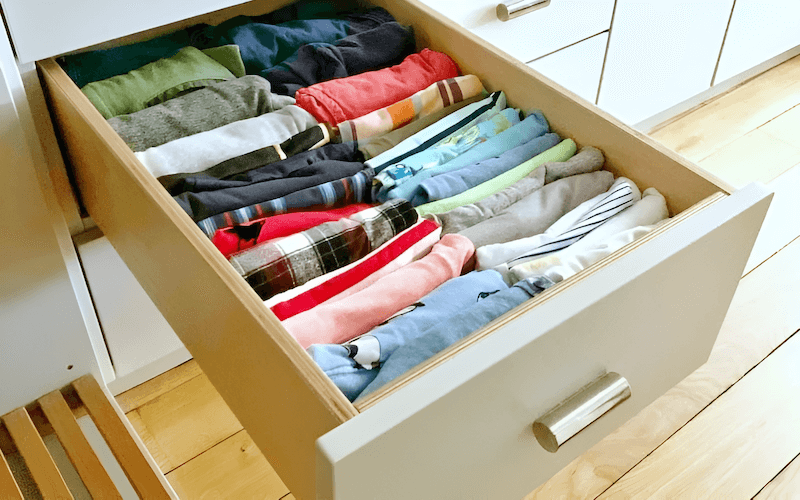
1.2 Prevent wrinkles and damage: Maintaining garment quality
Proper folding techniques are essential for maintaining the pristine condition of clothing inventory. Incorrect folding can lead to unsightly wrinkles, creases, and even permanent damage, such as stretching or fabric distortion. These issues diminish the perceived value of the garments and can lead to customer dissatisfaction, something that can be easily avoided.
By contrast, neatly folded clothes experience less stress and friction, minimizing the risk of wrinkles. This is particularly crucial for delicate fabrics, which can be easily damaged if folded improperly. By implementing consistent and correct folding practices, businesses can significantly reduce losses due to damaged goods and ensure that every item reaches the customer in perfect condition.
1.3 Improve organization and accessibility: Streamline your operations
Effective inventory management hinges on organization and accessibility. A well-organized stockroom, where clothes are neatly folded and categorized, significantly streamlines daily operations. When employees can quickly locate specific items, it saves valuable time and improves overall efficiency.
Proper folding contributes directly to this organization. Clothes folded uniformly are easier to categorize, stack, and label, creating a visually ordered system. This, in turn, reduces the time spent searching for specific items, minimizing delays and potential frustration for both staff and customers.
Imagine the difference between searching for a specific size of a t-shirt in a jumbled pile versus a neatly organized drawer where each size is clearly visible and easily accessible. The latter scenario represents a far more efficient and professional operation.
1.4 Enhance presentation: Making a good first impression (Even in storage)
While seemingly behind-the-scenes, the way clothes are folded and stored contributes significantly to a business’s overall presentation. Neatly folded clothes, even within a stockroom or storage area, create a visual impression of order and professionalism. This attention to detail, though subtle, reflects a commitment to quality that extends to all aspects of the business.
A tidy and organized storage space suggests careful handling of merchandise, instilling confidence in both employees and any potential visitors (e.g., suppliers, partners). Furthermore, well-maintained storage practices ensure that when clothes are pulled for display or customer orders, they are in presentable condition, ready to make a positive first impression.
1.5 Long-term preservation: Protecting your investment
For clothing businesses, inventory represents a significant financial investment. Proper folding and storage are crucial for preserving the quality of garments over extended periods, particularly for seasonal items or those held in stock for longer durations. Incorrect storage can lead to fabric degradation, discoloration, and even damage from pests, all of which can result in financial losses.
Consistent folding practices, combined with appropriate storage solutions (discussed later in this guide), create a protective environment that minimizes these risks. By prioritizing long-term preservation, businesses safeguard their investment and ensure that inventory remains in sellable condition, maximizing its value over time. Think of it as preventative maintenance for your clothing stock – a small effort upfront that yields significant long-term benefits.
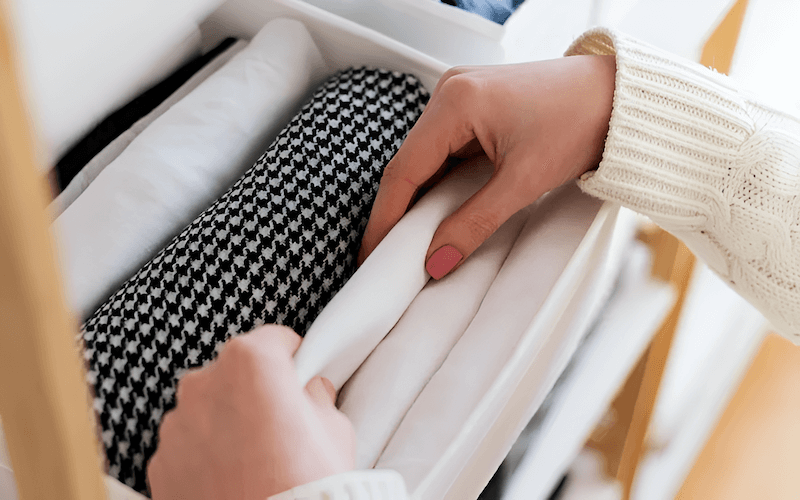
2. Essential folding techniques: A step-by-step guide
2.1 The basic flat fold (for T-shirts, most tops)
The basic flat fold is a fundamental technique for folding T-shirts and many other types of tops. It’s a quick, simple method that results in a neat, rectangular shape, ideal for stacking or storing in drawers. Here’s a step-by-step guide:
- Lay flat: Begin by laying the T-shirt face down on a clean, flat surface, such as a table or countertop. Smooth out any wrinkles with your hands.
- Fold one side: Fold one side of the shirt towards the center, bringing the sleeve across the back. Aim for a fold line that runs roughly from the shoulder seam to the bottom hem.
- Fold sleeve back: Fold the sleeve back on itself so that it lies flat along the folded portion of the shirt.
- Repeat on other side: Repeat steps 2 and 3 on the opposite side of the shirt. You should now have a long, rectangular shape.
- Fold in half (or thirds): Fold the bottom hem of the shirt up towards the neckline. For shorter shirts, fold in half. For longer shirts, you may prefer to fold in thirds to create a more compact package.
- Smooth and store: Smooth out any remaining wrinkles, and your T-shirt is ready to be stacked on a shelf or placed vertically in a drawer.
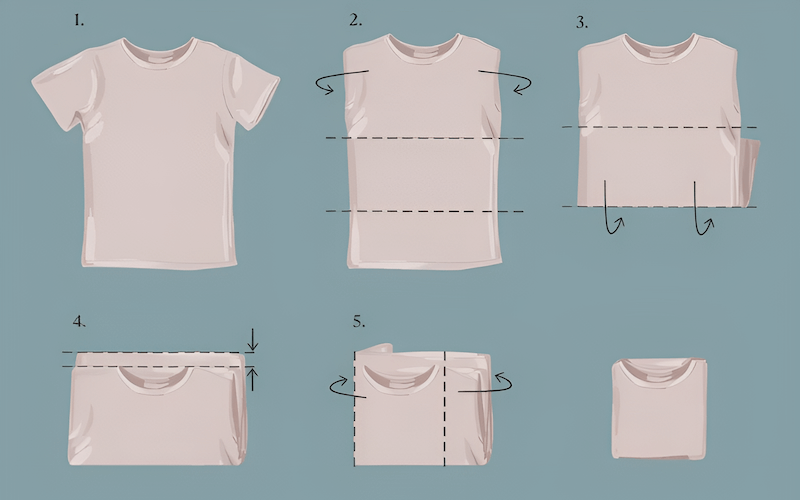
2.2 The KonMari method (Vertical folding)
The KonMari Method, popularized by Marie Kondo, offers a unique approach to folding that emphasizes vertical storage. While the “spark joy” philosophy is central to the KonMari Method, this section focuses on the practical benefits of vertical folding for businesses.
- Initial fold: Lay the garment flat, just like with the basic flat fold.
- Fold in half lengthwise: Fold one side of the garment over to meet the other, creating a long, narrow rectangle.
- Fold in half (or thirds) again: Fold the top of the rectangle down towards the bottom. Depending on the length of the garment, you’ll fold it either in half or in thirds. The goal is to create a small, self-standing rectangle. The key is to leave a small gap at the edge, to reduce pressure and prevent wrinkles.
- Stand upright: The folded garment should now be able to stand upright on its own.
This vertical folding technique allows clothes to be stored standing up in drawers, making every item visible and easily accessible. The major advantage is that every garment will be visible when the drawer is open.
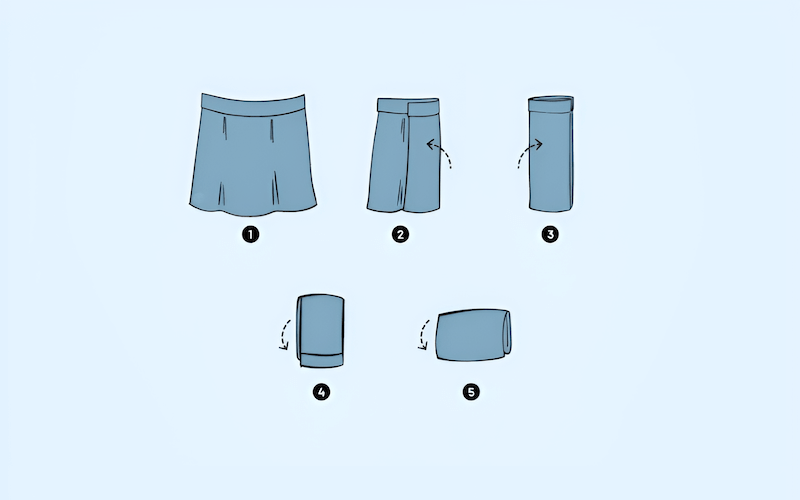
2.3 Folding dress shirts (Buttoned)
Folding dress shirts requires a bit more care to maintain their crisp appearance. The key is to button the shirt completely before starting, which helps prevent wrinkles and ensures a neat fold.
- Button up: Begin by buttoning all the buttons on the shirt, from the collar to the bottom hem. This is crucial for a smooth, wrinkle-free fold.
- Lay flat, face down: Place the buttoned shirt face down on a clean, flat surface. Smooth out any visible wrinkles.
- Fold one sleeve: Fold one sleeve across the back of the shirt, aligning the cuff with the opposite shoulder.
- Fold sleeve down: Fold the sleeve back down on itself, creating a straight line along the side of the shirt. The cuff should now be pointing towards the bottom hem.
- Repeat on other side: Repeat steps 3 and 4 with the other sleeve. The shirt should now have a narrower, rectangular shape.
- Fold bottom up: Fold the bottom third of the shirt upwards, towards the collar.
- Fold again: Fold the shirt in half again, bringing the folded bottom edge up to meet the collar.
- Flip and store: Flip the shirt over so that the buttoned front is facing up. It’s now ready for storage.
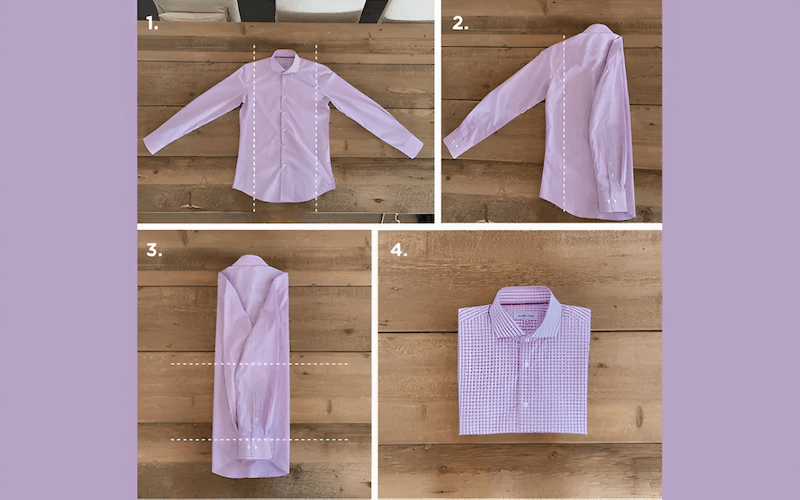
2.4 Folding pants (Dress pants and jeans)
Folding pants correctly depends on the type of pants. Dress pants require a fold that preserves the crease, while jeans can be folded more casually. Therefore, we’ll provide separate instructions for each.
Dress pants:
- Align and smooth: Start by laying the dress pants flat on a surface. Align the legs, ensuring the creases are sharp and the seams are matched. Smooth out any wrinkles.
- Fold in half lengthwise: Fold the pants in half lengthwise, bringing one leg directly over the other. The creases should align perfectly.
- Fold in half (or thirds): Fold the pants in half from the bottom hem towards the waistband. If you have limited drawer or shelf space, you can fold them in thirds instead.
- Preserve the crease: Throughout the folding process, ensure the crease remains sharp and defined.
Jeans:
- Lay flat: Place the jeans flat on a surface. Smooth out the pockets and any wrinkles.
- Fold in half lengthwise: Fold the jeans in half lengthwise, bringing one leg over the other.
- Fold the crotch (optional): For a more compact fold, you can fold the protruding crotch area inward, creating a more streamlined rectangle.
- Fold in half (or thirds): Fold the jeans in half from the bottom hem towards the waistband. For bulkier jeans or limited storage space, fold them in thirds.

2.5 Folding sweaters (Preventing stretching)
Folding sweaters properly is crucial to prevent stretching, especially at the shoulders. Hanging heavy sweaters can cause them to lose their shape over time. This folding method minimizes stress on the fabric.
- Lay flat: Place the sweater face down on a clean, flat surface. Smooth out any wrinkles.
- Fold sleeves across: Fold one sleeve across the back of the sweater, as if the sweater is giving itself a hug.
- Repeat on other side: Repeat with the other sleeve, so both sleeves are crossed over the back of the sweater.
- Fold in half (or thirds): For thinner sweaters, fold the bottom hem up to meet the neckline. For bulkier sweaters, fold in thirds to create a more compact and manageable shape. This prevents excessive weight from pulling on the shoulders.
- Handle delicately: If dealing with very delicate or embellished sweaters, consider placing a sheet of acid-free tissue paper between the layers to provide extra protection.
2.6 Folding dresses and skirts
Folding dresses and skirts requires an adaptable approach, considering variations in length and fabric.
- Lay flat: Place the dress or skirt flat on a clean surface. Smooth out any wrinkles.
- Fold in half lengthwise (Initial fold): Fold the garment in half lengthwise. For wider skirts or dresses, you might fold them into thirds lengthwise initially.
- Address straps (for dresses): If the dress has straps, tuck them neatly inside the folded garment.
- Fold in half or thirds (Lengthwise fold):
- Short dresses/skirts: Fold in half, bringing the hem to the waistline or neckline.
- Midi dresses/skirts: Fold in thirds.
- Maxi dresses/skirts: Fold in thirds or even fourths, depending on the length and your storage space. The goal is to create a compact, manageable rectangle.
- Consider fabric: For delicate fabrics like silk or lace, consider using acid-free tissue paper between folds to prevent damage or creasing.
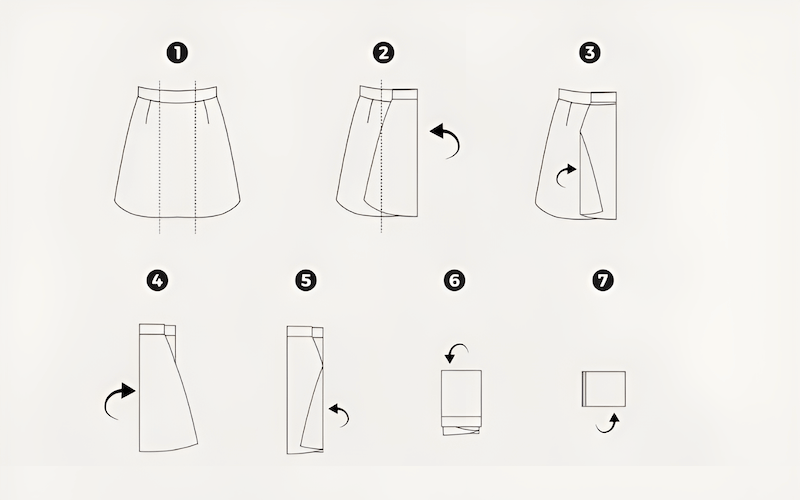
2.7 Folding underwear and socks
Even small items like underwear and socks benefit from proper folding, maximizing space and creating a tidy drawer.
Underwear (Briefs, boxers, panties):
- Lay flat: Place the underwear flat on a surface.
- Fold in thirds (sides): Fold one side towards the center, then repeat with the other side, creating a narrow rectangle.
- Fold in half (or thirds): Fold the bottom up towards the waistband. For smaller underwear, fold in half. For larger items, fold in thirds.
Socks (Ankle, crew, knee-high):
- Pair and lay flat: Place the pair of socks together, one on top of the other.
- Ankle socks: Fold in half or thirds, depending on the size.
- Crew socks: Fold in thirds, bringing the toe up towards the cuff, and then folding the cuff down over the folded portion.
- Knee-high socks: Fold in thirds or fourths, depending on the length. You can tuck the top of one sock over the folded bundle to keep them together. Do not turn one sock’s cuff over the other completely, to avoid stretching the garment.
2.8 Folding tank tops
Folding tank tops is similar to folding T-shirts, with a slight adjustment for the straps.
- Lay flat: Place the tank top face down on a clean, flat surface.
- Fold in half lengthwise: Fold one side of the tank top over to meet the other, creating a long, narrow rectangle.
- Tuck straps (if needed): If the straps are very long or thin, tuck them inside the folded portion of the tank top.
- Fold in half or thirds: Fold the bottom of the tank top up towards the neckline. Fold in half for shorter tank tops, and in thirds for longer ones.
- Finishing: The tank top should be a square now.
3. Choosing the right storage solutions
3.1 Drawers vs. shelves: When to use each
The choice between drawers and shelves for storing folded clothes depends on several factors, including the type of garment, visibility, and accessibility needs.
Drawers:
- Advantages: Drawers offer excellent protection from dust and light, helping to preserve the condition of clothing. They’re ideal for smaller items like underwear, socks, T-shirts, and folded knitwear. Drawers also provide a more concealed storage solution, creating a cleaner, less cluttered look.
- Disadvantages: Visibility can be limited, especially in deeper drawers. It can be harder to see all items at a glance, potentially leading to items being forgotten or overlooked.
- Best for: Underwear, socks, T-shirts, tank tops, pajamas, and smaller folded items.
Shelves:
- Advantages: Shelves offer excellent visibility and accessibility. It’s easy to see all items at a glance, making it easier to find what you’re looking for. Shelves are well-suited for bulkier items like folded sweaters, jeans, and sweatshirts.
- Disadvantages: Shelves offer less protection from dust and light. Clothes may be more prone to fading or becoming dusty over time.
- Best for: Sweaters, jeans, sweatshirts, folded pants, and other bulkier items. Also suitable for frequently accessed items.
| Feature | Drawers | Shelves |
|---|---|---|
| Visibility | Limited, especially in deep drawers | Excellent, all items visible at a glance |
| Accessibility | Can be limited, items may be hidden | Excellent, easy to access all items |
| Protection | Good protection from dust and light | Less protection from dust and light |
| Garment Types | Underwear, socks, T-shirts, smaller items | Sweaters, jeans, sweatshirts, bulkier items |
| Space Efficiency | Can be very space-efficient with organizers | Can be less space-efficient for small items |
3.2 Drawer organizers and dividers: Keeping things tidy
Drawer organizers and dividers are essential tools for maintaining order within drawers, preventing clothes from becoming jumbled, and maximizing space. They create designated compartments for different types of clothing, making it easier to find specific items and keep everything neatly organized.
Types of organizers:
- Compartment organizers: These organizers feature pre-defined compartments, often used for underwear, socks, and accessories.
- Adjustable dividers: These dividers can be customized to fit the specific dimensions of your drawers and the size of your folded clothes. They’re ideal for creating flexible storage solutions.
- Honeycomb organizers: With its special shape, this organizer is very suitable for storing socks.
Benefits:
- Improved organization: Organizers prevent clothes from shifting and becoming mixed up.
- Space optimization: They make efficient use of drawer space, allowing you to store more items.
- Enhanced visibility: By separating items, organizers make it easier to see everything in the drawer.
It’s highly recommended to all clothing businesses to use organizers and dividers to maintain a perfectly organized inventory.
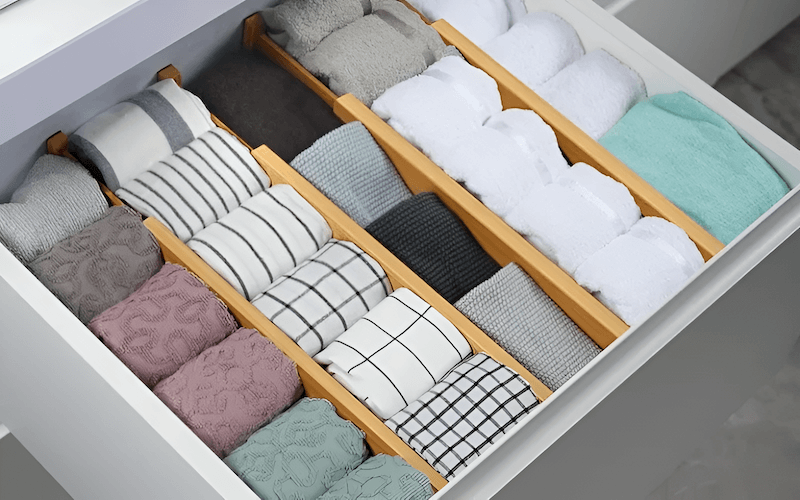
3.3 Vacuum storage bags: For long-term and seasonal storage
Vacuum storage bags are a valuable tool for long-term and seasonal clothing storage, offering significant space-saving benefits and protection from environmental factors.
Benefits:
- Compression: Vacuum bags remove air, significantly reducing the volume of bulky items like sweaters, winter coats, and blankets. This frees up valuable storage space.
- Protection: They create an airtight seal, protecting clothes from dust, moisture, pests (moths, silverfish), and odors.
- Ideal for seasonal storage: Vacuum bags are perfect for storing out-of-season clothing, keeping it protected until needed.
How to Use:
- Clean and dry: Ensure clothes are clean and completely dry before placing them in the bag.
- Fold neatly: Fold clothes neatly to minimize wrinkles.
- Seal and vacuum: Seal the bag tightly and use a vacuum cleaner to remove the air.
Note: While providing good protection, for some clothes that are too delicate, using vacuum storage bags is not recommended.
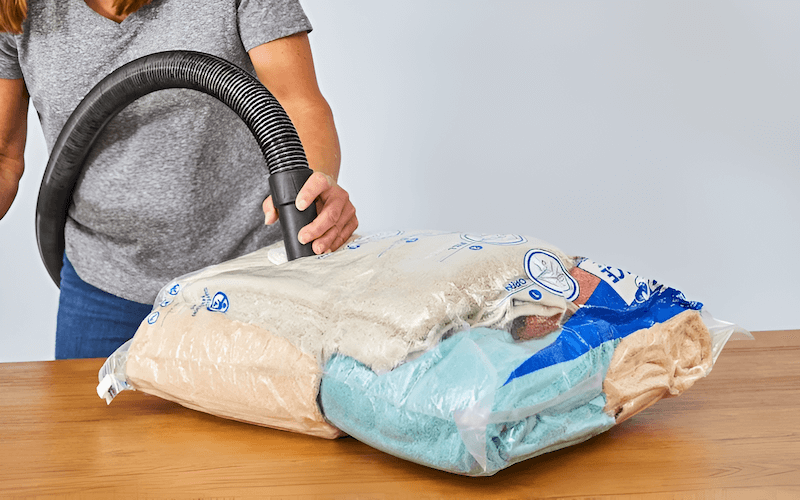
3.4 Storage bins and boxes: Protecting from dust and pests
Storage bins and boxes are essential for protecting clothes from dust, pests, light, and other environmental factors, especially during long-term storage.
Types of bins and boxes:
- Plastic bins: Durable, stackable, and often airtight, plastic bins offer excellent protection. Clear plastic bins allow for visibility.
- Fabric-covered boxes: These boxes offer a more aesthetically pleasing option and can be suitable for storing less delicate items.
- Acid-free boxes: For delicate or valuable garments, acid-free boxes provide the best protection against yellowing and degradation.
Benefits:
- Protection: Bins and boxes shield clothes from dust, pests, light, and moisture (if airtight).
- Organization: They allow for easy stacking and labeling, creating a well-organized storage system.
- Long-term storage: Ideal for storing items that are not frequently accessed.
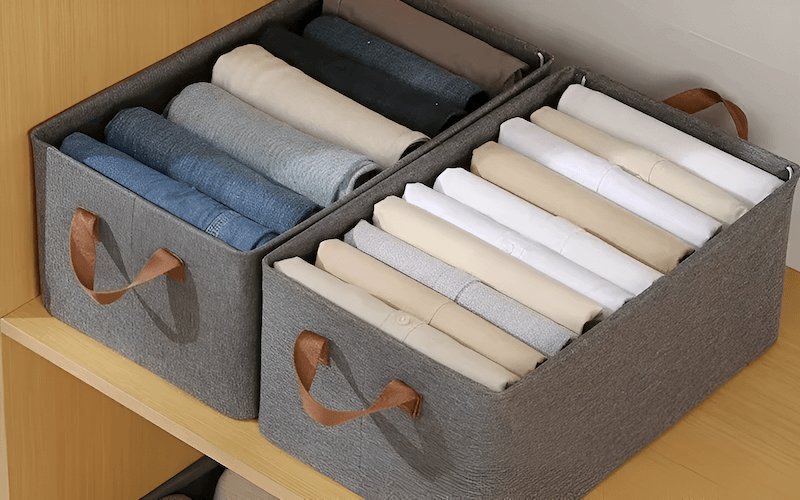
3.5 Garments Bag: For delicate items and formalwear
Garment bags are specifically designed to protect delicate fabrics, formalwear, and items that are best stored hanging.
Benefits: Garment bags shield clothing from dust, wrinkles, and potential damage during storage or transport. They are particularly important for items like suits, dresses, coats, and any garments made of delicate materials such as silk, lace, or embellished fabrics.
Usage: Hanging storage is preferred for these items to maintain their shape and prevent creasing. Garment bags also offer a convenient solution for travel, protecting clothes from wrinkles and dirt while in transit.
Considerations: Garment bags should also be considered for long-term storage of special occasion wear, preserving their condition and ensuring they are ready for use when needed. Proper care and storage contribute significantly to the longevity of these valuable garments.
3.6 Under-bed storage: Maximizing unused space
Under-bed storage containers offer a practical solution for maximizing storage space, particularly in situations where stockroom space is limited. While often associated with home storage, this option can be relevant for small clothing businesses with space constraints.
Benefits:
- Space optimization: Utilizes the often-unused space under beds, freeing up valuable floor and shelf space in the main storage area.
- Suitable for out-of-season inventory: Under-bed storage is well-suited for storing out-of-season clothing or items that are not frequently accessed.
- Discreet storage: Keeps inventory out of sight, maintaining a cleaner and more organized appearance in the main business area.
Types of containers:
- Rolling bins: Easy to access, even when fully loaded.
- Zip-up bags: Offer protection from dust and pests.
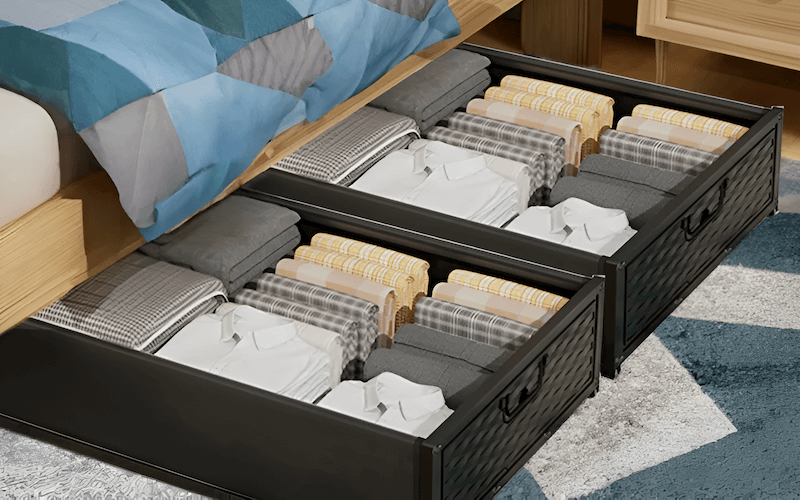
3.7. Fabric storage bags: Alternative solutions.
Fabric storage bags offer another viable option for protecting clothing.
Benefit: Breathable fabric bags are particularly useful for storing items made of natural fibers, such as cotton, linen, or wool. They are suitable to protect clothes
Usage: The breathable material allows for air circulation, preventing the buildup of moisture and mildew, which can damage these types of fabrics.
Suggestion: While plastic bins offer airtight protection, fabric bags provide a gentler storage solution for garments that benefit from ventilation. They can be used for both short-term and long-term storage, offering a balance between protection and breathability.
4. Long-term clothing storage: Preserving your inventory
4.1 Cleaning clothes before storage: Preventing damage
One of the most crucial steps in long-term clothing storage is ensuring that all garments are thoroughly cleaned before being stored. This prevents a range of potential problems that can arise during extended storage.
Why clean before storage?
- Prevent stains: Food stains, perspiration, and even seemingly invisible residues can oxidize over time, leading to permanent discoloration and damage.
- Eliminate odors: Body oils and perfumes can linger on clothes, leading to unpleasant odors that can become embedded in the fabric over time.
- Deter pests: Food particles and other residues can attract pests like moths and silverfish, which can cause significant damage to clothing.
Cleaning methods:
- Washing: Most garments can be machine-washed or hand-washed according to their care labels.
- Dry cleaning: Delicate fabrics or items with special embellishments may require dry cleaning.
- Ensure complete dryness: Before storing, ensure that all clothes are completely dry to prevent mildew growth.
4.2 Choosing the right storage environment: Temperature and humidity
The environment in which clothes are stored plays a critical role in their long-term preservation. Temperature and humidity fluctuations can significantly impact fabric integrity.
Ideal conditions:
- Cool: A cool environment helps slow down the chemical processes that can cause fabric degradation.
- Dry: Low humidity is essential to prevent mold and mildew growth, which can stain and damage clothing.
- Dark: Exposure to light, especially direct sunlight, can cause colors to fade and fibers to weaken.
Recommendations:
- Avoid Attics and Basements: These areas are often prone to extreme temperature and humidity fluctuations.
- Climate-Controlled Storage: If possible, a climate-controlled storage unit is ideal for long-term storage.
- Ideal Ranges: Aim for a temperature range of 65-75°F (18-24°C) and a relative humidity of around 40-50%.
4.3 Protecting against pests (Moths, silverfish)
Protecting clothes from pests like moths and silverfish is crucial during long-term storage. These insects feed on natural fibers, causing holes and irreversible damage.
Prevention Strategies:
- Cleanliness: As mentioned earlier, clean clothes are less attractive to pests.
- Airtight Containers: Storage bins with airtight seals provide a physical barrier against pests.
- Natural Repellents:
- Cedar Blocks/Chips: Cedarwood contains natural oils that repel moths.
- Lavender Sachets: Lavender is another natural moth repellent.
Avoid Chemical Mothballs: Mothballs contain harsh chemicals that can be harmful to humans and pets, and the odor can be difficult to remove from clothing.
4.4 Using acid-free tissue paper for delicate fabrics
For delicate fabrics like silk, lace, and garments with embellishments, using acid-free tissue paper is essential for long-term preservation.
Why acid-free?
- Prevents yellowing: Regular tissue paper can contain acids that can transfer to fabrics over time, causing yellowing or discoloration.
- Protects embellishments: Tissue paper provides a buffer between delicate embellishments (beads, sequins) and the fabric, preventing snagging or damage.
- Minimizes creasing: Tissue paper can help cushion folds, reducing the risk of permanent creasing.
How to use:
Wrap Individual Items: Wrap each delicate garment in acid-free tissue paper.

4.5 Periodic inspection and refolding
Even with the best storage practices, periodic inspection of stored clothes is recommended to ensure their long-term preservation.
Frequency: Aim to inspect stored clothes every 6-12 months.
What to check for:
- Signs of damage: Look for any signs of discoloration, stains, or fabric degradation.
- Pest activity: Check for any evidence of moths, silverfish, or other pests.
- Moisture: Ensure that the storage environment remains dry and that there are no signs of moisture or mildew.
Refolding: Refold clothes to prevent permanent creasing and to redistribute any stress on the fabric. This also provides an opportunity to air out the garments.
5. Tips for specific fabric types
5.1 How to store cotton
Cotton, a natural fiber, is known for its breathability. Proper storage involves maintaining this quality while preventing wrinkles.
Key Considerations:
- Breathability: Cotton needs to breathe, so avoid storing it in airtight plastic containers for extended periods. This can trap moisture and lead to mildew.
- Wrinkle prevention: Cotton is prone to wrinkling, so proper folding is essential.
- Cleaning: Always clean cotton items before storing them to prevent stains and pest infestations.
Recommended storage:
- Fabric storage bags: These allow for air circulation while protecting against dust.
- Well-ventilated space: Store in a cool, dry, and well-ventilated area.
- Proper folding: Use the folding techniques described earlier to minimize wrinkles.
5.2 How to store silk
Silk, a delicate and luxurious natural fiber, requires special care during storage.
Key considerations:
- Avoid sunlight: Direct sunlight can cause silk to fade and weaken.
- Prevent crushing: Silk is prone to creasing, so avoid packing it tightly.
- Acid-free paper: Essential for preventing yellowing and damage.
- Avoid plastic: Plastic can trap moisture and damage silk.
Recommended storage:
- Acid-free tissue paper: Wrap individual silk items in acid-free tissue paper.
- Garment bag (for hanging): For dresses and blouses, a breathable garment bag is ideal.
- Cool, dark place: Store in a cool, dark, and dry environment.
- Gentle folding or rolling: If folding, use a gentle method and place tissue paper between folds. Rolling can also be a good option to prevent creases.
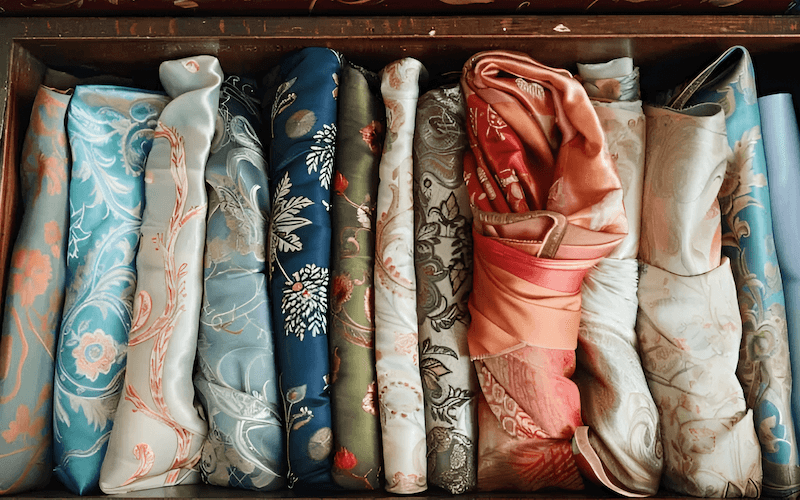
5.3 How to store wool
Wool, a natural fiber known for its warmth, requires specific storage techniques, primarily focused on moth prevention.
Key considerations:
- Moth prevention: Wool is highly susceptible to moth damage.
- Cleaning: Always clean wool items thoroughly before storage, as moths are attracted to dirt and body oils.
- Ventilation: Wool benefits from good air circulation.
- Avoid stretching: Hanging heavy wool items can cause them to stretch.
Recommended storage:
- Cedar blocks or lavender sachets: Place these natural repellents among stored wool items.
- Breathable storage bags: Fabric storage bags or cotton bins allow for ventilation.
- Clean before storing: Ensure all wool items are clean before storing.
- Proper folding: Fold sweaters and other wool items using the techniques described earlier to prevent stretching.
5.4 How to store Linen
Linen, a natural fiber made from flax, is known for its strength and breathability, but it’s also prone to wrinkling.
Key Considerations:
- Wrinkle prevention: Linen wrinkles easily, so proper folding or rolling is essential.
- Cool, dry place: Like other natural fibers, linen benefits from a cool, dry storage environment.
- Breathability: Avoid storing linen in airtight plastic containers for extended periods.
Recommended storage:
- Proper folding or rolling: Use gentle folding techniques, or consider rolling linen items to minimize wrinkles.
- Fabric storage bags: These allow for air circulation.
- Cool, dry location: Store in a cool, dry place away from direct sunlight.
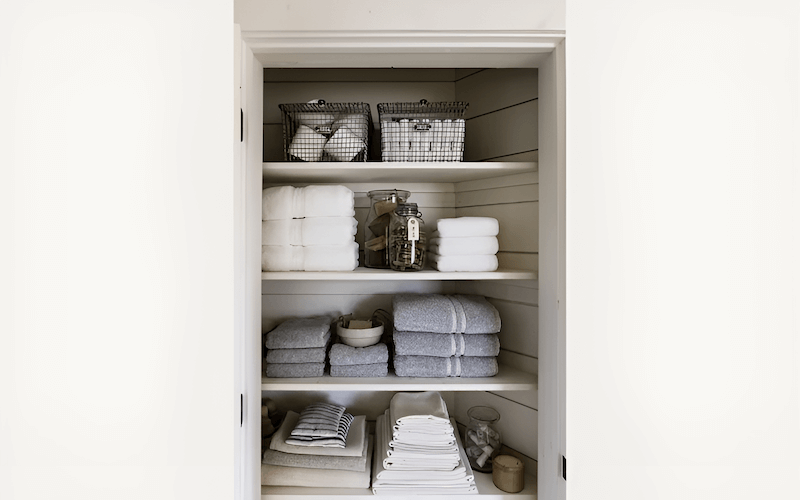
5.5 How to store Polyester
Polyester, a synthetic fabric, is known for its durability and wrinkle resistance. However, proper storage still matters.
Key Considerations:
- Wrinkle resistance: Polyester is generally wrinkle-resistant, making it relatively easy to store.
- Static cling: Polyester can be prone to static cling, especially in dry environments.
- Breathability: While more durable than natural fibers, breathability considerations are still relevant for long-term storage.
Recommended Storage:
- Folding: Standard folding methods.
- Storage solutions: Bins, boxes.
- Fabric softener sheets: Can reduce Static Cling.
6. Related Questions
6.1 Can I use mothballs to protect my clothes?
While mothballs are effective at killing moths, they contain harsh chemicals that can be harmful to humans and pets. The odor can also be very difficult to remove from clothing. Natural repellents like cedar and lavender are safer and more pleasant alternatives.
6.2 How often should I refold stored clothes?
It’s a good idea to refold clothes every 6-12 months to prevent permanent creasing and to check for any signs of damage or pests.
6.3 What’s the best way to store clothes I wear frequently?
For clothes you wear often, prioritize accessibility. Use shelves or drawers that allow you to easily see and retrieve items.
6.4 Is it better to roll or fold clothes?
Rolling can be a good option for saving space, especially when packing for travel. However, for everyday storage, folding often provides better organization and accessibility. The best method depends on the specific garment and your storage space.
6.5 What’s the ideal temperature for the storage?
Aim for a temperature range of 65-75°F (18-24°C) and a relative humidity of around 40-50%.
6.6 Should I iron the clothes before storing?
For clothes that will be stored for a long time, ironing is not necessary, and should only be washed.
Read more:
Proper clothing folding and storage are essential for any clothing business, protecting inventory, maximizing space, and streamlining operations. By implementing the techniques outlined in this guide, businesses can ensure that garments remain in pristine condition, ready to impress customers and contribute to a successful and efficient operation.
From basic folding methods to long-term storage strategies, this comprehensive approach covers all aspects of clothing care, helping businesses of all sizes protect their investment and maintain a high standard of quality. Remember, attention to detail in these seemingly small tasks can have a significant impact on the overall success of a clothing business.
Visit our website https://mypacklove.com/ to explore our product options and request a quote. Contact us today to discuss your specific needs! Let us help you enhance your clothing care and branding efforts.






















